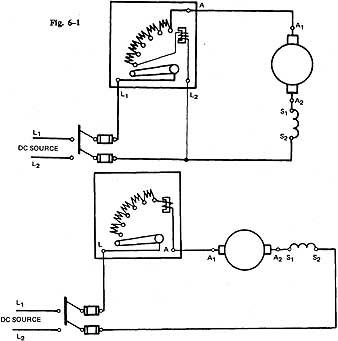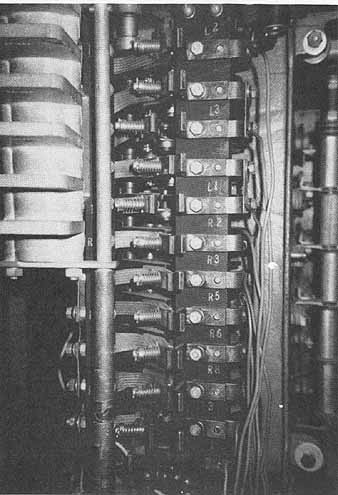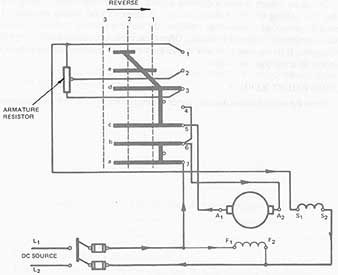AMAZON multi-meters discounts AMAZON oscilloscope discounts
OBJECTIVES
• describe the operation of a series motor starter with no-voltage protection.
• describe the operation of a series motor starter with no-load protection.
• describe the actions occurring at each forward and reverse position of a drum controller.
Series motors require a special type of starting rheostat called a series motor starter. These starting rheostats serve the same purpose as the three- and four-terminal starting rheostats used with shunt and compound motors. However, the internal and external connections for the series motor starter differ from the connections of the other types of starting rheostats.
Series and cumulative compound motors are often used for special industrial applications which require provisions for reversing the direction of rotation and varying the speed of the motor. A manually operated controller, called a drum controller, may be used for these applications. The operation of drum controllers is discussed later in this unit.
STARTING RHEOSTATS FOR DC SERIES MOTORS
Series motor starting rheostats are of two types: one type of starter has no-voltage protection, and the other type has no-load protection.
Starter with No-Voltage Protection
A series motor starter with no-voltage protection is illustrated in 1. The holding coil circuit of this starter is connected across the source voltage. There is no shunt field connection on this type of starter as it's used only with series motors. This type of starter is used to accelerate the motor to rated speed. In the event of voltage failure, the holding coil no longer acts as an electromagnet. The spring reset then quickly returns the arm to the off position. Thus, the motor is protected from possible damage due to low-voltage conditions.
To disconnect a motor using this type of starting rheostat, open the line switch. Check to be sure that the arm returns to the off position.

ill. 1 Series motor starter with no-voltage protection
ill. 2 Series motor starter with no-load protection
Starter with No-Load Protection
A series motor starter with no-load protection is illustrated in 2. The holding coil is in series with the armature circuit. Because of the relatively large current in the armature circuit, the holding coil consists of only a few turns of heavy wire. Note in the figure that separate terminal connections for the shunt field and holding coil are not pro vided. There are only two terminals-one marked L (line) and one marked A (armature).
The same care is required in starting a motor with this type of starting rheostat as is required with three- and four-terminal starting rheostats. The arm is slowly moved from the off position to the run position, pausing on each contact button for a period of one to two seconds. The arm is held against the tension of the reset spring by the holding coil connected in series with the armature. If the load current to the motor drops to a low value, the holding coil weakens and the reset spring returns the arm to the off position. This is an important protective feature. Recall that a series motor may reach a dangerously high speed at light loads. Therefore, if the motor current drops to such a low value that the speed becomes dangerous, the holding coil will release the arm to the off position. In this way, it's possible to avoid damage to the motor due to excessive speeds.
To stop a series motor connected to this type of starting rheostat, open the line switch. Check to be sure that the arm returns to the off position.
DRUM CONTROLLERS
Drum controllers are used when an operator is controlling the motor directly. The drum controller is used to start, stop, reverse, and vary the speed of a motor. This type of controller is used on crane motors, elevators, machine tools, and other applications in heavy industry. As a result, the drum controller must be more rugged than the starting rheostat.

ill. 3 Drum type controller shows contact fingers.
A drum controller with its cover removed is illustrated in 3. The switch consists of a series of contacts mounted on a movable cylinder. The contacts, which are insulated from the cylinder and from one another, are called movable contacts. There is another set of contacts, called stationary contacts, located inside the controller. These stationary contacts are arranged to touch the movable contacts as the cylinder is rotated. A handle, keyed to the shaft for the movable cylinder and contacts, is located on top of the drum controller. This handle can be moved either clockwise or counterclockwise to give a range of speed control in either direction of rotation. The handle can remain stationary in either the forward or reverse direction due to a roller and a notched wheel. A spring forces the roller into one of the notches at each successive position of the controller handle to keep the cylinder and movable contacts stationary until the handle is moved by the operator.

ill. 4: Schematic diagram of a drum controller connected
to a compound-wound motor
A drum controller with two steps of resistance is illustrated in 4. The contacts are represented in a flat position in this schematic diagram to make it easier to trace the circuit connections. To operate the motor in the forward direction, the set of contacts on the right must make contact with the center stationary contacts. Operation in the reverse direction requires that the set of movable contacts on the left makes contact with the center stationary contacts.

ill. 5 First position of controller for reverse direction
Note in figure 4 that there are three forward positions and three reverse positions to which the controller handle can be set. In the first forward position, all of the resistance is in series with the armature. The circuit path for the first forward position is as follows:
1. Movable fingers a, b, c, and d contact the stationary contacts 7, 5, 4, and 3.
2. The current path is from the positive side of the line to contact 7, from 7 to a, from a to b, from b to 5, and then to armature terminal A1.
3. After passing through the armature winding to terminal A the current path is to stationary contact 6, and then to stationary contact 4.
4. From contact 4 the current path is to contact c, to d, and then to contact 3.
5. The current path then goes through the armature resistor, to the series field, and then back to the negative side of the line.
The shunt field of the compound motor is connected across the source voltage. On the second forward position of the controller handle, part of the resistance is cut out. The third forward position cuts out all of the resistance and puts the armature circuit directly across the source voltage.
In the first reverse position, all of the resistance is inserted in series with the armature. ill 5 shows the first position of the controller in the reverse direction. The cur rent in the armature circuit's reversed. However, the current direction in the shunt and series fields is the same as the direction for the forward positions. Remember that an earlier unit showed that a change in current direction in the armature only resulted in a change in the direction of rotation.
The second reverse position cuts out part of the resistance circuit. The third reverse position cuts out all of the resistance and puts the armature circuit directly across the source. Drum controllers with more positions for a greater control of speed can be obtained. How ever, these controllers all use the same type of circuit arrangement shown in this unit.
SUMMARY
DC series motors require a different starting controller than shunt or compound motor. The holding circuit for the controller is in series with the starting resistance. If there is a low-voltage or no-voltage condition, the starter is returned to the off position. Drum controllers are still used frequently. Often drum controllers are used with ac as well as dc motors. It is important to be able to read the connection diagrams and the sequence diagrams on drum-type controllers.
QUIZ
1. Show the internal connections of a series starting rheostat with no-voltage protection.
2. Show the internal connections of a series starting rheostat with no-load protection.
3. Show the circuit connections for a series motor used with a series starting rheostat with no-load protection.
4. Show the circuit connections for a series motor used with a series starting rheostat with no voltage protection.
5. Why is a drum controller used in many industrial applications?
Complete the following statements.
6. In a series starter with no-voltage protection, the holding coil is connected across the ___
7. A series starter with no-load protection is used to prevent the series motor from reaching _______ at low loads.
8. A drum controller gives the following types of control for a direct-current motor: ______